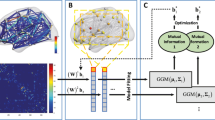Abstract
The human brain forms a large-scale, interconnected network when performing different activities. To compare networks extracted from different subjects, they are first converted into sparse graphs with similar densities to reveal topological differences. Graph analysis is then applied to the sparse graphs to extract global and local graph invariants for quantitative comparisons. However, many previous works not only studied global and local graph invariants separately, but also created only one single sparse graph for each subject, potentially excluding important factors in connectome analysis. In this work, we adopt a more inclusive approach: generating multiple graphs using different density thresholds for each subject; and describing each graph with both global and local graph invariants. A machine learning approach is then applied to analyze these comprehensive datasets. We show that our inclusive approach can help machine learning methods to automatically identify most discriminating factors in predicting brain activities with much higher accuracy than the previous exclusive approaches.
Access this chapter
Tax calculation will be finalised at checkout
Purchases are for personal use only
Preview
Unable to display preview. Download preview PDF.
Similar content being viewed by others
References
Human Connectome Project A neurobiologically grounded connectome. http://humanconnectome.org/about/project/neurobiologically-grounded-connectome.html (accessed April 15, 2015)
Alpaydin, E.: Introduction to machine learning. MIT press (2014)
Barch, D.M., Burgess, G.C., Harms, M.P., et al.: Function in the human connectome: task-fMRI and individual differences in behavior. Neuroimage 80, 169–189 (2013)
Bogdanov, P., Dereli, N., Bassett, D.S., et al.: Learning about Learning: Human Brain Sub-Network Biomarkers in fMRI Data (2014). ar**v preprint ar**v:1407.5590
Breiman, L.: Random forests. Machine learning 45(1), 5–32 (2001)
Cao, M., Wang, J., Dai, Z., et al.: Topological organization of the human brain functional connectome across the lifespan. Developmental Cognitive Neuroscience 7, 76–93 (2014)
Craddock, R.C., Tungaraza, R.L., Milham, M.P.: Connectomics and new approaches for analyzing human brain functional connectivity. GigaScience 4(1), 13 (2015)
Destrieux, C., Fischl, B., Dale, A., et al.: Automatic parcellation of human cortical gyri and sulci using standard anatomical nomenclature. Neuroimage 53(1), 1–15 (2010)
Fornito, A., Zalesky, A., Breakspear, M.: Graph analysis of the human connectome: promise, progress, and pitfalls. Neuroimage 80, 426–444 (2013)
Glasser, M.F., Sotiropoulos, S.N., Wilson, J.A., et al.: The minimal preprocessing pipelines for the Human Connectome Project. Neuroimage 80, 105–124 (2013)
Hagmann, P.: From diffusion MRI to brain connectomics. Ph.D. Thesis, Institut de traitement des signaux (2005)
Hastie, T., Tibshirani, R., Friedman, J., et al.: The elements of statistical learning, vol. 2. Springer (2009)
Kulkarni, V., Pudipeddi, J.S., Akoglu, L., et al.: Sex differences in the human connectome. In: Brain and Health Informatics, pp. 82–91. Springer (2013)
Lyons, I.M., Beilock, S.L.: Mathematics anxiety: Separating the math from the anxiety. Cerebral Cortex: bhr289 (2011)
Marsland, S.: Machine learning: an algorithmic perspective. CRC press (2014)
Ommen, J.: Analytics of Human Brain Connectome Networks. Master Thesis (draft under preparation), University of St. Thomas (2015)
Reijneveld, J.C., Ponten, S.C., Berendse, H.W., et al.: The application of graph theoretical analysis to complex networks in the brain. Clinical Neurophysiology 118(11), 2317–2331 (2007)
Robinson, E.C., Hammers, A., Ericsson, A., et al.: Identifying population differences in whole-brain structural networks: a machine learning approach. Neuroimage 50(3), 910–919 (2010)
Rubinov, M., Sporns, O.: Complex network measures of brain connectivity: uses and interpretations. Neuroimage 52(3), 1059–1069 (2010)
Sporns, O., Tononi, G., Kötter, R.: The human connectome: a structural description of the human brain. PLoS computational biology 1(4), e42 (2005)
Wijk, V., Bernadette, C.M., Stam, C.J., Daffertshofer, A.: Comparing brain networks of different size and connectivity density using graph theory. PloS one 5(10), e13701 (2010)
Wang, L., Yu, C., Chen, H., et al.: Dynamic functional reorganization of the motor execution network after stroke. Brain 133(4), 1224–1238 (2010)
Zhou, J., Gennatas, E.D., Kramer, J.H., et al.: Predicting regional neurodegeneration from the healthy brain functional connectome. Neuron 73(6), 1216–1227 (2012)
Author information
Authors and Affiliations
Corresponding author
Editor information
Editors and Affiliations
Rights and permissions
Copyright information
© 2015 Springer International Publishing Switzerland
About this paper
Cite this paper
Ommen, J., Lai, C. (2015). Identifying Distinguishing Factors in Predicting Brain Activities – An Inclusive Machine Learning Approach. In: Guo, Y., Friston, K., Aldo, F., Hill, S., Peng, H. (eds) Brain Informatics and Health. BIH 2015. Lecture Notes in Computer Science(), vol 9250. Springer, Cham. https://doi.org/10.1007/978-3-319-23344-4_9
Download citation
DOI: https://doi.org/10.1007/978-3-319-23344-4_9
Published:
Publisher Name: Springer, Cham
Print ISBN: 978-3-319-23343-7
Online ISBN: 978-3-319-23344-4
eBook Packages: Computer ScienceComputer Science (R0)




